So, I have been getting quite a few questions lately about how I am able to reduce our energy bills! Other than to say I’m cheap 😉 there are plenty of practical things we’ve been doing over the years to keep our energy costs low!
Here’s a look at our recent billing:
- The amount of $131.47 for account number ******16730 is due on 2/4/2013.
- The amount of $60.78 for account number ******16730 is due on 3/6/2013.
- The amount of $49.74 for account number ******16730 is due on 4/5/2013.
- The amount of $19.51 for account number ******16730 is due on 5/6/2013.
- The amount of $17.35 for account number ******16730 is due on 6/5/2013.
- The amount of $14.98 for account number ******16730 is due on 7/5/2013.
- The amount of $13.27 for account number ******16730 is due on 8/6/2013.
- The amount of $10.83 for account number ******16730 is due on 9/4/2013.
- The amount of $11.68 for account number ******16730 is due on 10/4/2013.
- The amount of $11.51 for account number ******16730 is due on 11/4/2013.
- The amount of $12.88 for account number ******16730 is due on 12/4/2013.
- The amount of $38.42 for account number ******16730 is due on 1/3/2014.
- The amount of $94.86 for account number ******16730 is due on 2/4/2014.
- The amount of $69.84 for account number ******16730 is due on 3/6/2014.
- The amount of $38.20 for account number ******16730 is due on 4/7/2014.
- The amount of $33.12 for account number ******16730 is due on 5/6/2014.
- The amount of $18.65 for account number ******16730 is due on 6/5/2014.
- The amount of $55.02 for account number ****4304 is due on 1/30/2014.
- The amount of $58.44 for account number ****4304 is due on 3/3/2014.
- The amount of $48.43 for account number ****4304 is due on 4/1/2014.
- The amount of $41.07 for account number ****4304 is due on 4/30/2014.
- The amount of $38.78 for account number ****4304 is due on 5/30/2014.
- The amount of $38.19 for account number ****4304 is due on 6/30/2014.
- The amount of $40.41 for account number ****4304 is due on 7/30/2014.
We had a minor setback this winter as the igniter on our 10-year-old heater conked out in the middle of a rain storm on a Friday night! *sigh* After several DIY attempts to fix the problem, we ended up purchasing an inexpensive 800w electric space heater and ran that on and off for 12 hours. I think we could have survived without the heater, but I was unsure of how long it would take for repairs with it being the weekend and we were all sick. Energy budget savings more than covered the $200 service and repair bill though! 😀
Here in the Sacramento area, our gas and electric are provided by PG&E and SMUD respectively, and both of these utilities offer some type of savings or discount program whether it be based on usage or income. I hadn’t realized that a significant amount of our recent energy savings has been through PG & E’s Winter Gas Savings Program! This program offers consumers a 10% – 20% discount for reducing natural gas usage during peak months. Definitely a great incentive to conserve! But, our bill reductions did not only stem from this awesome program. We have been very vigilant in our energy saving and are very pleased with the cost reduction our sacrifices have afforded us!
While there are many ways to cut costs with utilities, these are just some of the simple things that we have done since becoming home owners 5 years ago. And many of these ideas are free! Keep in mind, we do live in Northern California and enjoy reasonably mild winters (average daily highs may be in the 60°s and lows in the 30°s) with no snow, ice storms, blizzards, etc. The spring and dry summer heat, though, can fluctuate anywhere between 80° and 113° and last well into October! So, the tips I am sharing may not be practical for everyone, but can perhaps be modified to fit your climatic needs.
(UPDATE: Gov. Jerry Brown has recently declared a drought emergency and has asked California residents to reduce water use by as much as 20% as the state suffers through the worst drought conditions in history.)
Kill Your Bill!
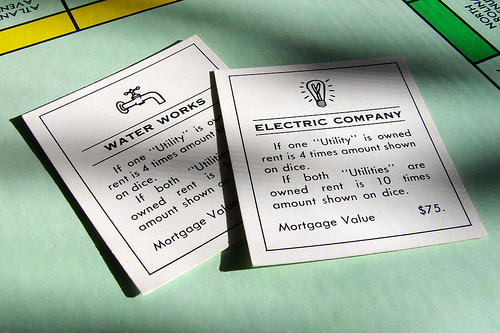 (image credit)
(image credit)
-
Shop Around – If you live in an area that allows for competition, shop around and see if you’re being offered the lowest rates and the best discounts! The American Coalition of Competitive Energy Suppliers (ACCES) offers a state-by-state list of competitive retail natural gas and electricity suppliers. Although many cities may not offer this choice, you can still inquire about peak and non-peak hours for consumption and adjust usage accordingly.
-
Compare Past Usage – Start your energy savings by comparing your previous usage. What season do you have your highest bills? Winter? Summer? On average, are your bills the same every month, or are they spiking by season?
-
Look for Discounts – Do you qualify for a discount based on income? Are you enrolled in an energy saving plan? Does your employer offer any type of discount? Have you contacted your energy company to see what they recommend as far as reducing costs?
-
Go Paperless – Many companies offer a discount for simply opting out of receiving a paper copy of the bill! You can still view your bill online and even compare usage from month to month.
-
Set Up Payments – I have our monthly bill payments set on “autopay” with a maximum “approved” amount of $50. That means, I have authorized any monthly payments up to $50, and anything over that amount I will need to go online and pay. This keeps me aware of our energy usage and helps in figuring out where those huge bills are coming from!
In the Bathroom:
-
Cut Shower Time – We limit the amount of time spent in the shower with the water running. I can remember staying with family friends in Santa Barbara in the early 80s. There was a huge water crisis in Southern California at the time and the county was publishing the names of homeowners that used more water than was allowed. We were given less than 5 minutes in the shower (the family had timers stuck on the shower doors!), and while that seemed drastic, you really don’t need more than that to do the job. Saves on water usage and gas to heat the hot water. Like my mom would scream at us as teenagers through the bathroom door, “DON’T SOAK!!“
-
‘If it’s yellow, let it mellow. If it’s brown, flush it down.‘ Or something like that, right? Lotty dotty, we don’t always flush the potty! 😉
- Shaving is Saving – I got into the habit of shaving my legs in the bathtub after showering. This saves a ton of water!
- Kids in the Tub – Are your kiddos bathing in a mini-swimming pool every night, with bath water up to their chests?! So much water is wasted by filling up the tub, (especially as you are waiting for the water to heat up) and you really don’t need to fill it more than just a couple of inches. Believe it or not, I don’t bathe my son every night. There are some days he honestly doesn’t need it, and he tends to get really dry and irritated skin from the hard water in our city. I bathe him in the tub (only when needed, water just to his knees) during the week, and then when my husband is home on the weekends, they shower together.
-
Stop Running the Water – Teach children (or husbands, ahem) to turn off the faucet when brushing teeth, lathering up hands, shaving, washing faces, etc.
-
Stop Motion – Install a motion detector in high traffic or kiddy bathrooms. No motion after 3 minutes? Lights out and no nagging about turning off the lights!
In the Laundry Room:
(image credit)
-
Set a Wash Schedule – I have gotten into a routine with my laundry and only wash on certain days. I do 1 load during the week (M – Th) and then maybe 3 on the weekends when my husband is home. I wash all of the bedding once a month and the sheets every couple of weeks. I wash the towels every two weeks. This may seem extreme (and probably not practical for a larger family), but keeping a “wash schedule” has really helped in reducing energy costs.
- Wear it Again – We wear our clothes several times before they are truly “wash worthy”. Okay, The Boy’s clothes may not last more than a day or two, but usually we can stretch outfits a few wearings. Doing this saves on water, energy, and soap! Cut your detergent/softener use by 1/3 or more and the savings really adds up!
-
Wash Full Loads – When the laundry is finally good and dirty, I only wash a full load of clothes. If you get that “emergency” call for just one needed item, try to fill the load as best you can, or remember to reduce the water level and washing time.
- Cold Water Washing – I only wash and rinse the clothes in cold water! In fact, in the 5 years I have owned my washer, I have only used the hot water setting 3 times just recently to get rid of the sour smell on the towels! I have never had any problems getting our clothes clean on the cold cycle, and my husband is a forester, so I know from dirt in the wash! 😉
- Dryer, Shmyer – In February of 2014, we decided to “kill” our dryer! We made a commitment to stop running the dryer (almost completely) and to see how that small change impacted our energy costs. We purchased a foldable drying rack (just like the one we have back home in Europe, as there are no dryers!) and feel we have saved a considerable amount on our energy bills. The only occasions we run the dryer these days are to dry my husband’s work uniforms (just takes a quick minute once a week to get the wrinkles out!) and on the days I wash the bedding. I set the drying rack up either upstairs in a sunny room, in the hallway, or downstairs in the playroom and a full load is dry in about 24 hours. (As allergy season passes and the yellow and green “snow” stops blowing *sigh*, I will move the rack outdoors and add a line under our pergola.) Yes, we do have to plan on not having clothes ready to wear “on demand”, but this also helps with us wearing more of the clothes in our closet. I think Oprah said it once: “You wear 20% of what you own 80% of the time.” Well, we are definitely getting more wear in and getting our money’s worth from our clothing before items end up in the “never even wore it” donation box! 😉
- Hang Dry – Clothes lines, folding drying racks, draped on the furniture, hanging from the shower rod…. This seems obvious enough, but even when the weather is not so great we try to hang dry. When we were in Europe last year, I was surprised to see so many people hanging clothes to “dry” in the snow! May take a bit longer, but it really works! Remember to add a bit of liquid fabric softener to the washer, and if you don’t like that ‘crunchy’ feeling with air-dried clothes, you can toss them in the dryer for a few minutes to soften them up afterwards. The clothes do soften right up just fine with wear though.
- Drying Time – If you must run the dryer, let the heat work for you, not against you. Run the machine at night in the warmer months to avoid heating up the house unnecessarily making you rely more on the AC. In the winter, run the dryer in the early morning to help get the house heated up a bit.
- Just Stop It – Do not rely on the timer to turn off the dryer. If possible, check the load after about 30 minutes or so (I set the oven timer) to see if the clothes are dry, or dry enough, to take out.
- Trapper Lint, M.D. – Be sure to clean out the lint trap on the dryer after every use. Pull out the tray and rinse or wipe it down thoroughly and also vacuum and wipe down the inside of the lint area on the dryer. Lots of flammable gunk gets trapped down in there – get the dryer vent on the outside of the house too!
In the Kitchen:
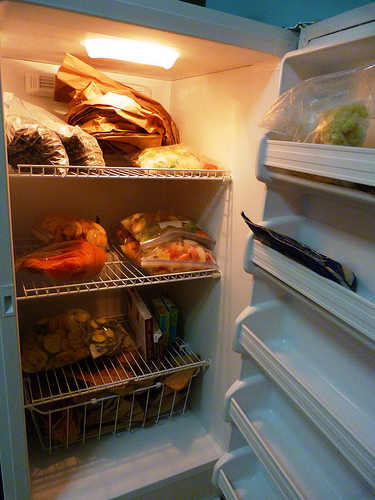 (image credit)
(image credit)
- Adjust the Temps on the Fridge and Freezer – We have our refrigerator set between 35°F and 38°F and both freezers set at about 0°F. Having a 2nd freezer can be a big energy drain, but our side-by-side is so small that freezing and storing practical amounts of food is not possible. So, it’s just a cost we have to bear in order to effectively plan and stock for meals.
- Don’t Stare – This one is kind of impossible to manage, especially if you have kids or ever get hungry, but try not to spend hours gawking inside the fridge or the freezer with the door open. Meh, at least check to make sure the door is closed tightly when you’re done figuring out there is nothing to eat in there.
- Cool It Now – If safe, cool hot foods down before placing them in the refrigerator or freezer. Putting hot foods in will raise the temperature of the ice box and cause it to have to work harder to bring the temperature back down again. This also brings other foods to potentially unsafe temperatures.
-
Oven Time – Plan your oven usage wisely. It takes a lot of energy to heat up and run a large oven, and it also adds a lot of unnecessary heat to the house in the warmer months. Cook multiple dishes at once, plan a day of “freezer” meal prep and cook batches of meals to store in the freezer, or consider using a smaller toaster oven.
-
Defrost foods before cooking – Uses a lot less energy and reduces cooking time!
-
May the Heat Be with You – In the colder months, leave the oven door open a crack after cooking, making sure the oven is off and little ones are not likely to wander in the kitchen. Let the residual heat from the oven heat up the kitchen and surrounding areas. Otherwise, keep the door closed for more efficient cooking times and to trap the unwanted heat in.
-
Dishwasher Off Duty – I don’t think there is a household task that I loathe more than dish washing. That being said, I try to do it as little as possible. 😉 I only run a full load (be careful, an overloaded washer won’t allow for dishes to be cleaned properly and you’ll end up using more time and energy to rewash by hand or run the load again!) and I try to limit the time of day I run the washer to avoid peak energy use. I also don’t use the “dry” function (if I can catch it in time) and just open the door and let the dishes air dry.
Around the House:
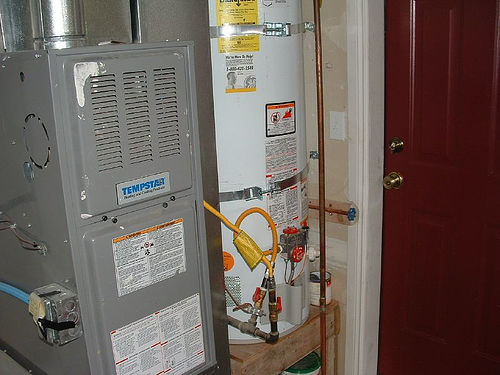 (image credit)
(image credit)
-
NO PEAKING! – Try to avoid running major appliances (AC, dishwasher, washers, dryers, etc.) during peak usage times when energy demand is high. Typically in the warmer months this is anywhere between the hours of 12 p.m. and 6 p.m.
-
Lower the Temp on the Water Heater – We did this as a safety precaution when our son was born, but lowering the temperature on your water heater can save an average of 10% on your energy bill!
- Time It – Consider adding a timer to your water heater.
- Blow It Out – If you will be away from home for an extended period of time, have your water heater turned off.
- No More Wire Dust Bunnies – Get in there and vacuum the coils and doo-dads of larger household appliances every few months to keep them working more efficiently.
- Unplug – We unplugged all appliances/devices not in current use – phone chargers, TV, DVD player, old desktop computer, etc. Those plugs are like little vampires sucking away bits of energy! And the items we do use are all on surge protectors for quick and easy powering down.
-
Laptops – Last year we chucked our old desktop and invested in 2 top of the line laptops. Making the switch from the desk to the lap not only saves on energy, but it also saves on electronic waste. We have gone through a number of towers (as they burn-out or age-out) and seeing them pile up for e-waste day (and knowing where they might end up, thank you John Stossel and 20/20!) is a bit depressing.
- Pure Energy – Be sure to set electronics to “energy saving” mode!
- Hit the lights – How many times did I hear growing up to turn off all the lights because we “didn’t own SMUD!” Well, now my 4 year old is also well-aware of that fact! Make like Nelly Furtado and “Turn Off the Light”!
- Change the Midnight Oil – Switch out those old night lights with the “Christmas tree” light bulbs for something like these Automatic Dusk-to-Dawn White LED Night Lights. Save money on energy & bulb replacement and it costs just $0.25 cents per year to operate!
- Dimmah Down Now – Control the juice and install dimmer switches on light fixtures.
- Speaking of Lights – Remember to turn off the porch light and any other outside lighting in the morning. Use solar-powered lighting, motion detectors, or timers to light only when necessary.
- Switch the Lights – Change out energy-zapping bulbs with CFL’s (compact fluorescent light bulbs) or invest in LED’s.
- A Tisket a Task-et – Use task lighting if possible. Desk lamps, reading lamps, range hood lamp…
- New Comfort Levels – In the colder months, we started setting the thermostat at around 66° – 67° during the day (which is pretty comfortable) and at night we set it to 68° – 69° – extra blankets at night and dress in layers during the day. During the warmer months, we N-ever run the AC until the thermostat indoors hits about 84° (and then only set it to about 79° or 80°, just enough to take the edge off). That seems to be the temperature where my cheapness and my discomfort intersect! 😉 But, we can stay cool by hanging out downstairs, running a portable fan, closing windows and curtains, going to the park, playing in the water, whatever.
-
Put a Ceil(ing) on the Heat – Install ceiling fans to help improve air circulation. Remember to turn them off though when rooms are unoccupied!
-
Shut. The. Front. Door – No seriously. Make sure exterior doors are closed properly at all times. The door from the house to the garage is just like what little Carol Ann went through to get in to the TV! Okay, not just like it, but it is a huge energy suck! 😉 The garage can either be an oven or a freezer depending on the weather and leaving that door cracked open the littlest bit allows for a rush of unwanted air.
-
Don’t Slam It – Close the doors and vents of unoccupied rooms. I can remember having to do this as a child growing up in a house with only a “wall unit” air conditioner. This would allow for the cool air to stay in the main living spaces and we would only have to run the AC for a short time. Even though we have dual temperature controls for both levels of our home, we close all of the doors upstairs to trap the heat in the summer.
We had some dear friends of ours visit from out of state one summer (on probably one of the hottest days we’d had so far!) and they remarked over and over about the temperature…….INSIDE our house! “How do you keep your house SO cool in this awful heat?! Do you have the AC turned way up?! You know, you should really close all of the windows if you do!” That was THE BEST compliment they could have given me as a hostess. That, and the second helpings of the yummy brownies I made! (Of course we did not have the AC on!)
- Air Out the House – I am usually up by 5 a.m. (or earlier) in the mornings, and in the warmer months I will open up all of the windows when I come downstairs. It doesn’t start getting “hot” until around 10 a.m. or so, and I like to take advantage of the natural AC while I can!
- Block Out the Sun – Vampire Style! In the warmer months, we close up all the curtains and blinds about mid-morning when the sun really begins to heat the house. There is still plenty of natural light as we have smaller windows above that are not covered. And we can open them back up as the sun passes over the house.
- Blackout – Cover sunny-side windows with blackout curtains or tinted film that will prevent heat from coming in during the warmer months and will trap heat indoors during the colder months.
- Let the Sun In – The reverse also works in the winter months. Open up all the blinds and curtains on sunny days to naturally heat up your house!
- Make Sure the A/C is not Blocked – Be sure to clear away any thing that may be blocking the AC condenser unit outdoors. Our unit sits right under the dryer vent and tends to collect lint, as well as leaves and plant debris. When you begin running the AC, check to make sure it is cleaned out and ready to cool the house effectively.
- Draft Picks – Make sure your windows and doors are properly insulated. You can install rubber door sweeps, update caulking, or even just roll up some old bath towels or blankets to seal up any drafty spots.
- Clear and Clean the Vents – The same goes for the inside! Make sure the areas around the vents are clear as well and that you are changing the filters on a regular basis. We are really bad at remembering to do this, but it makes a huge difference in how your unit operates. All that dust blocks airflow and you end up running the AC or heat a lot longer than you really need to be. And, changing that dusty filter will greatly better the lives of those with allergies or other respiratory issues.
- Fireplace Show – We do have a gas fireplace, but have never used it. When we first moved in, I was 7 months pregnant and smelled gas coming from the area of the fireplace. We called PG&E and they came right out (at 8:30 at night) and tested for leaks. Although one could not be found, I had them disconnect the fireplace just to be sure. Not because I was a crazy preggo lady. Okay, it might have been a little of that, but seriously we just would never have used the thing anyway. The radiant heating with our high ceilings and large living spaces would not heat the house efficiently. But it’s pretty to look at and we still have somewhere to hang our stockings. Oh, and the gas I smelled? Turns out our (former) neighbors were operating an illegally-(and-down-right-unsafe)-rigged gas kitchenette of sorts in their back yard. Yah, don’t miss them much.
In the Yard:
-
Plant a Tree – When we first moved in, there was a pretty huge (and terribly messy!) oak tree in our front yard, but it didn’t seem to produce enough shade. My husband planted a Sycamore seedling (Free from SMUD) and 4 years later, that tree has grown enough to shade the entire front of our home! We have one growing and thriving in the backyard now as well!
- Per—-gola! – Last summer, my husband built a pergola that spans the back half of our house. This has greatly reduced the heat levels in the kitchen and back family room – where we spend a majority of our time. Even before the pergola was built, we just used a pop-up canopy tent (like at a farmer’s market) and that was great for shading.
- Sprinkle! Sprinkle! If you have automated sprinklers or drip irrigation lines in your yard, be sure to adjust the timers according to season. Water early in the day or overnight in the summer, and only as necessary in the winter months.
- Barrel of Rain! Consider a rain barrel for your outdoor watering needs.
-
At the Car Wash! Remember to turn off the hose when washing the car or use a spray nozzle to control the flow.
Holidays!
- Lights! This holiday season, try being more aware of your outdoor decor such as lights and those blow-up things and the added cost of running the show. Isn’t that the first thing we all wonder when we visit those mega houses with the crazy light displays – “Sheesh! What does their power bill look like in January?!” Well, your house may not be a mega house, but your power bill may make you feel that way! 😉 Try turning your outdoor displays on at about dusk and remember to turn them off when you go to bed each night. Unless you live on a “Holiday Lights Tour” block, chances are nobody is seeing your outdoor light display after 8 p.m. or so. Pull the plug before you hit the sack! Those little lights are huge energy drainers and their twinkling can add up over time!
- Oh Christmas Tree! Plug in the Christmas tree or other indoor light displays after dinner, when the rooms start to naturally darken and you can actually see the lights, and turn them off as you go to bed. We are always eager to turn on the tree in the early mornings, but we have many times forgotten to turn it off! (Hard to see the lights are still on when the sun is shining! 😉 ) Set a timer for an hour or so to remind you to turn the lights off after breakfast.
- Digital Display! Consider switching all of those tangled up hand-me-down light strands to LED lights!
Get Educated!
- Learn to Read! Check your local library or power company to see if you can borrow a Kilowatt reader! These are small electronic devices that plug into an outlet and you then plug electrical items into the device. The reader will tell you how much electricity each item uses per hour, per minute, etc.
- TALK! We talk about being energy smart in our family ALL. THE. TIME. I never really appreciated the constant griping and nagging about energy use from my parents growing up, but I can see the importance of it now. We are all eager to teach our kids about being money-smart, why not do the same with energy conservation? We are always talking about ways we can conserve energy with our 4 year old and I am honestly getting a kick out of him gently reminding me to turn off a light because “It’s sunny time outside!“
What tips do you have for cutting down on home energy costs?
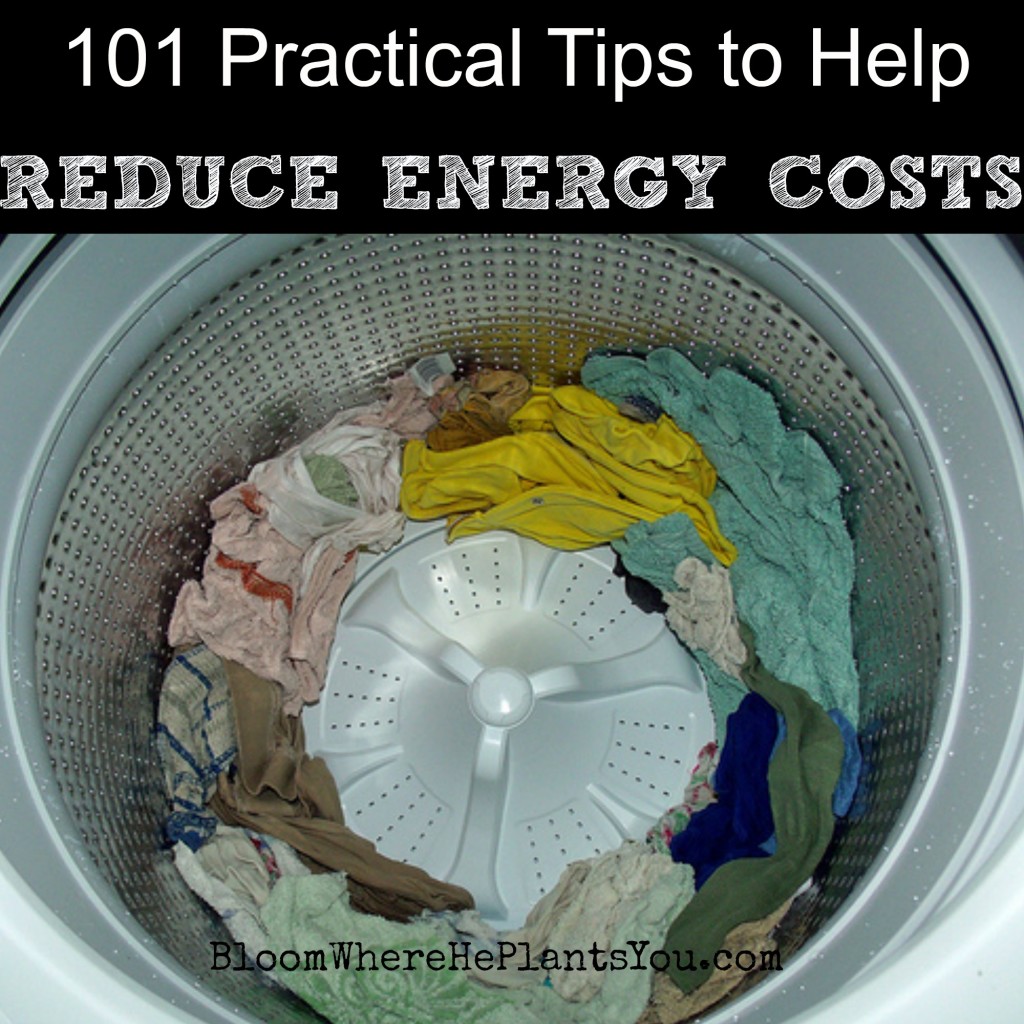


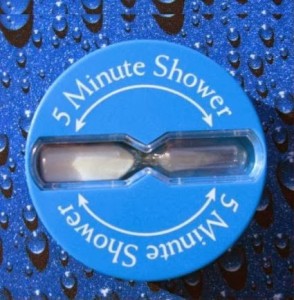
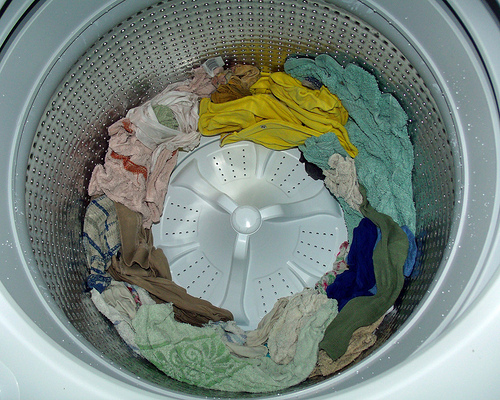
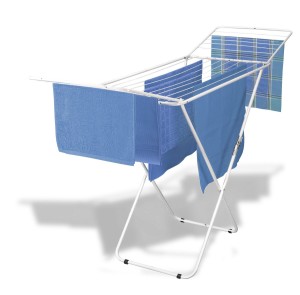
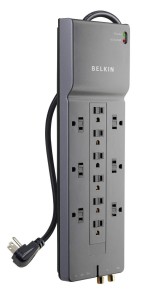

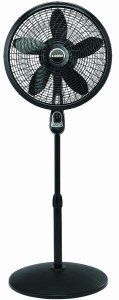
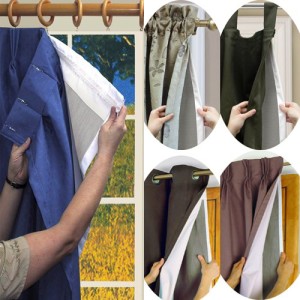
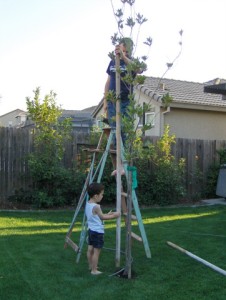
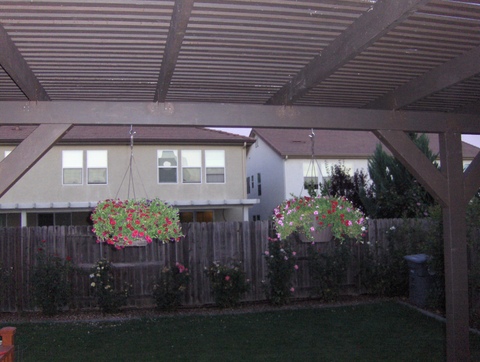

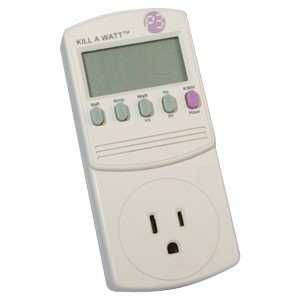

Most detailed tips to save on energy bills, very informative! I would like to add to it, if we can properly insulate our homes then it can help maintain normal temperature in our homes during winter and summer and avoid using the most energy guzzling appliances, AC and room heater.
Ron Pickle recently posted…How Clogged Gutters Cause Roof Leaks